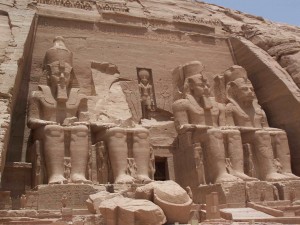
The sun illuminating the statue of Ramses II inside the Abu Simbel Temple twice a year is a known phenomenon that baffles scientists in the whole world by the greatness of the ancient Egyptians.
But the sun illuminating the ancient Archangel Michael Church in the Kafr El-Deir village of Sharqiya three times a year, as confirmed by the National Research Institute of Astronomy and Geophysics, is a peculiar phenomenon.
The church, which was built in the fourth century AD by Queen Helena among five other churches in the Delta, has become a tourist attraction. It is preparing for August 22, when the sun is expected to illuminate it for the third time, coinciding with the end of the Fast of the Assumption of the Virgin Mary.
Father Wissa Hifzi: It was discovered by chance
Father Wissa Hifzi, pastor of the church, said the phenomenon was discovered last year by chance while renovating the church and removing the small wooden covers that closed the holes in the dome for more than a thousand years.
He said the sun rays came in from a small hole in the dome above the Archangel Michael altar at 10:15 am and illuminated it for 60 minutes during a mass. “We showed it on a screen in the nave for the congregation to watch,” he said.
“The sun illuminates the first altar on May 1, which coincides with the St. George Feast, then the altar of Archangel Michael on June 19, which coincides with his birthday, and then the altar of the Virgin Mary on August 22, which coincides with the end of the Fast of the Assumption of the Virgin Mary,” he explained.
He said the architects followed the ancient Egyptian method of construction in building the church, allowing the sun to illuminate the inner sanctuary. “The Coptic architect was also a proficient astronomer,” he said. “It is a phenomenon similar to that of the Abu Simbel Temple.”
He said the church has a collection of icons, including one of St. George riding his horse, with a 15-year-old boy walking behind him and holding a jug, and a king walking in front of him. It tells the story of the son of the king of Georgia who was captivated by the Persians, but St. George rescued him and returned him to his father, who called his country Georgia after St. George.
Bishops and scientists check the phenomenon
Members of the National Research Institute of Astronomy and Geophysics, including Dr. Muslim Shaltout, Dr. Ashraf Tadros and Dr. Samir Nawar, came to the church among many other scientists and saw the phenomenon with Bishop Timotheus and Father Marbulous of Zagazig, Father Bishoy and Father Bakhoum Abdel Malak of the Virgin Mary Church, as well as many other clergymen and members of the Coptic Heritage Association.
Built in the Byzantine style
Ahmed Amer, a researcher of archaeology, said the church was built in a Byzantine style of architecture, with bricks and stones stabilized with a material similar to clay. It includes high domes that take the form of the cross. And it is divided into three sections for the communion, the prayers and the preachers.
He said the Archangel Michael altar, which is the main altar of the church, is covered with a veil made of acacia wood and ivory, and inscribed with drawings of church symbols. The second altar is of the Virgin Mary, which is covered with a more modern veil, while the third is of St. George with a similar veil.
Next to the St. George altar is a chamber that the monks hid themselves in during the ages of the persecution of Christians.
The northern and eastern entrances of the church lead to courtyards covered with vaults. They have huge wooden gates to protect the church.
Dr. Shaltout saw the phenomenon
Dr. Muslim Shaltout said that he saw the phenomenon on May 1 and that he will be present on August 22. “I asked the pastors to take coordinates of certain angles and altitudes for three days,” he said, adding that he will write about it to a major American scientific magazine in order to document the event. “It is based on intact astronomical calculations.”
Edited translation from Al-Masry Al-Youm
